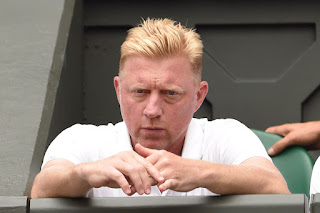Here is an article from USTA Today. Kind of interesting and thought-provoking...
It’s a practice probably as old as the game itself: coaching from the stands. It comes in many forms: subtle nods, a shifting of a hat, a wink or sometimes out-and-out verbal instructions. The procedure itself is illegal. The enforcement of said legality is a gray area that gains more scrutiny by the year.
The accusations have dogged Rafael Nadal since he arrived on the worldwide tennis scene, if you even want to call them accusations. If you watch his Uncle Toni during a match, you can see him and Nadal often make eye contact and I doubt it’s to bird dog Kate Middleton when she’s in attendance. Andy Murray talks to his box as much as he talks to the press. And at this Wimbledon, Novak Djokovic is fending off claims that his coach, former Wimbledon champion Boris Becker, has been coaching too and, therefore, cheating.
Becker didn’t help things when he admitted that “[we] have our ways” of signaling to Djokovic “to tell him it’s good or it’s bad,” a direct admission of coaching.
Both players have responded this week because, with the British press, everything is magnified at Wimbledon. Djokovic has been uncharacteristically testy when asked the question, saying that if he hasn’t been called for a violation on court, then he shouldn’t have to answer for it in the media. Nadal had a calmer, more rational response, though an ironic one given that the player he defeated before this press conference plays without a coach.
“It’s an old regulation. It was logical many years ago because some players had coaches, and others didn’t, so this was protection for those who didn’t have coaches, But now everybody has a coach so today I don’t see any player in this circuit who doesn’t have a coach so it’s rather absurd that everyone pays for a coach to help him and then when you need him the most you can’t talk to him.”
Who’s right? Are they cheating? Are they not? What should be done? In regular WTA events, after all, coaches are allowed to come on the court, just not in Grand Slams.
Well, the players are cheating by the letter of the law. But when umpires refuse to enforce the rule, then it’s like jaywalking or, in tennis terms, the time violations that are called so infrequently and arbitrarily. Therefore, it’s Nadal who has it pegged. Banning coaching from the box is an outdated rule and one that nobody enforces anyway. It’s like pitchers putting Bullfrog on their caps or batters using too much pine tar or
quarterbacks deflating footballs or professional teams making contact with free agents before the 12:01 a.m. deadline. It’s widely practiced, oft discussed and almost never enforced.
Here’s my suggestion: Don’t let the coaches come on the court, don’t let players go to the box for a sidebar, but short of holding up Chip Kelly-esque signage, allow a little communication between the pair. It makes things easier, it clears up any confusion and, let’s be honest, if a player needs a tip of his coach’s cap to let him know to stand back farther on the return of serve, then he’s not winning many matches anyway.



No comments:
Post a Comment